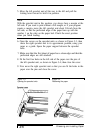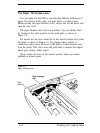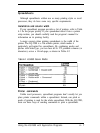
If you’re using control codes to select printer functions for an
application program or programming language, check the
documentation. Different programs and languages use different methods
of sending printer commands. The second half of this chapter covers
this process more thoroughly
Naming and using commands
In order to use printer commands, you should know how they are
recognized by your application program. The most common way of
naming codes or commands is with one of two numbering systems,
decimal or hexadecimal.
The decimal system is the standard numbering system based on units
of ten, using the numbers O-9.
The hexadecimal, or hex, system is based on units of 16, and is often
used by programmers. Instead of using only the numerals 0 through 9,
the hex system also uses the fetters A through E For example, the
decimal numbers 9, 10, 11, and 12 are 09, O9, OA, and OC in hex.
The most frequently used hexadecimal numbers lie in the range 0 to
FF hex (0 to 255 in decimal). Its common to write hexadecimal
numbers that are less than 16 with a zero in front.
In this book, hex numbers are distinguished from decimal numbers
by the word hex after them (for example, 1B hex). Other common ways
of denoting a hexadecimal number are:
1BH
$lB &lB
&HlB
<(1B>H
The Command Summary and the Quick Reference Card give both
the decimal and hex numbers for each command.
Setting Up Application Programs
Some application programs require nothing more than selecting the
correct printer. Other programs, however, require specific information to
take full advantage of a printers features.
Because there are literally thousands of application programs
available, only three general categories are addressed here: Word
Using the LQ-2500 with Application Programs
4-3


















